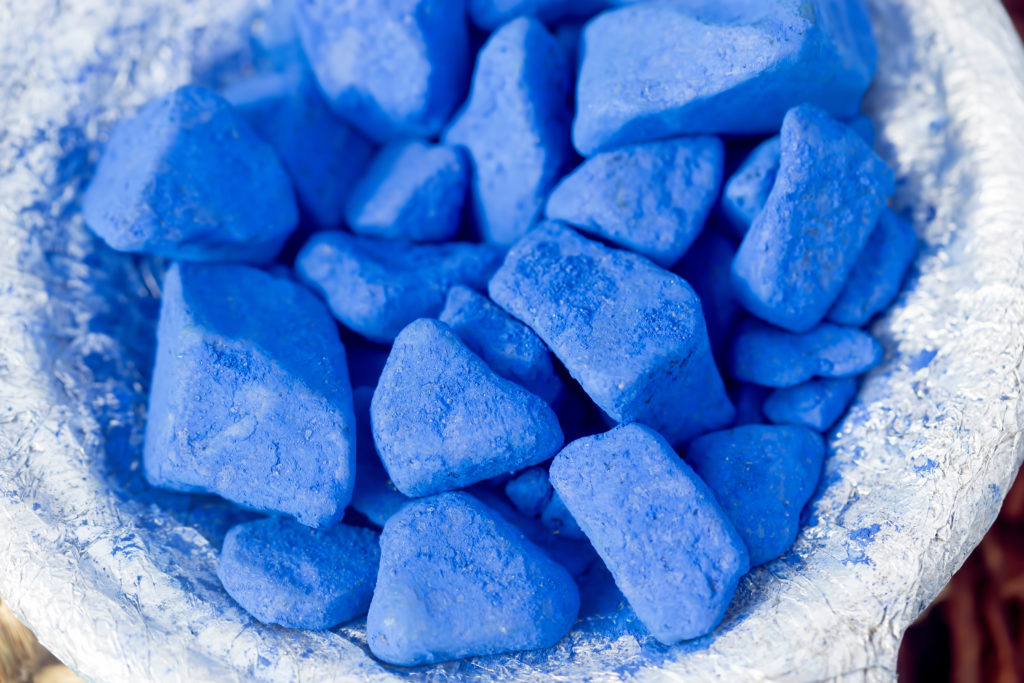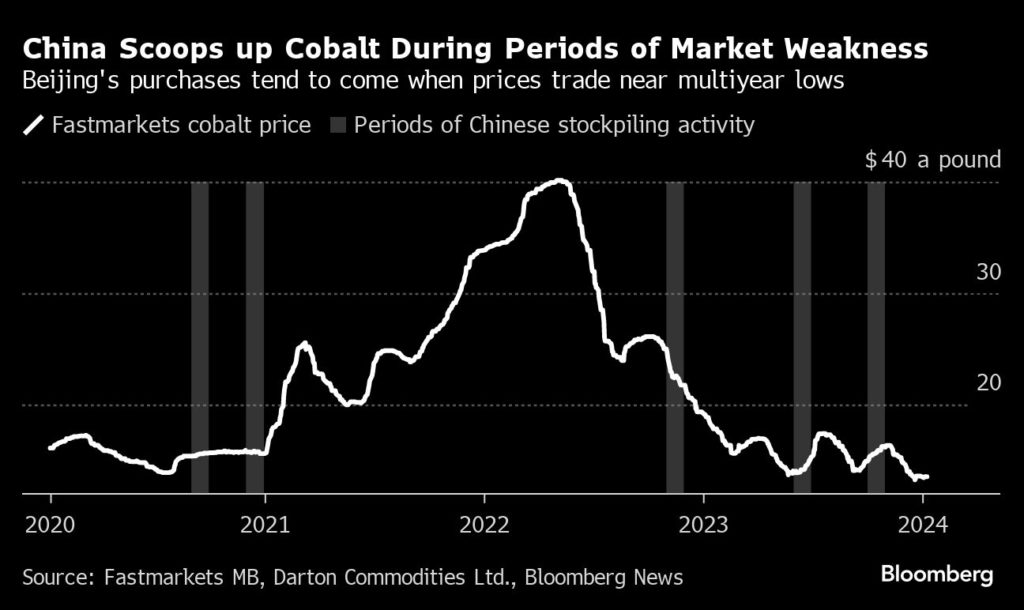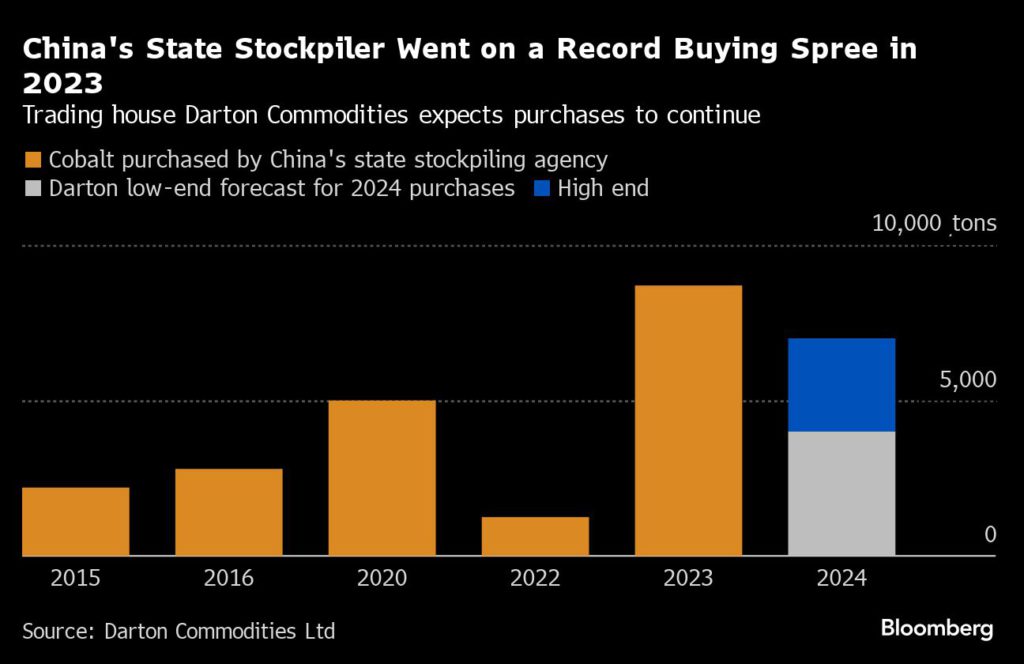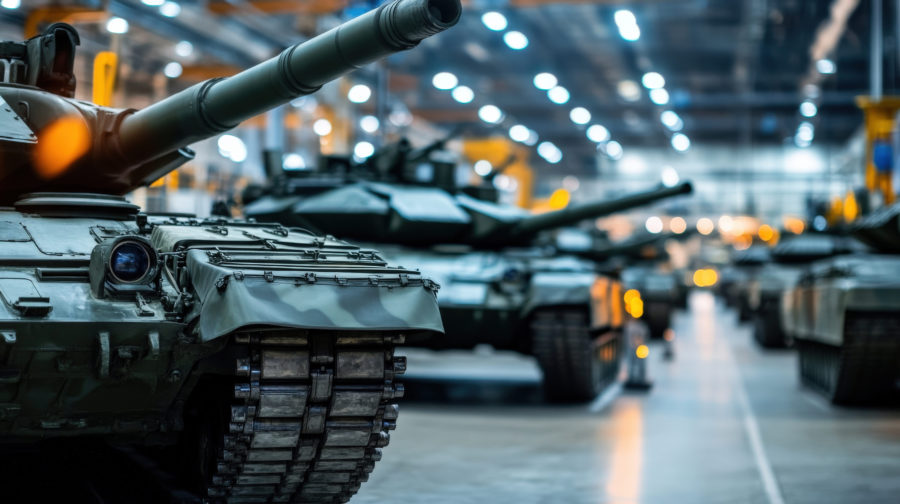US moves to restore stockpiling ‘panic button’ in EV metals fight with China

Insiders liken it to a “panic button.” And for more than 80 years, the primary job of the National Defense Stockpile has been to keep the US military supplied with essential raw materials and protect against supply shocks.
So when China surprised the markets by restricting exports of two niche industrial metals last year, top-level officials in the Pentagon-controlled agency—and the White House—faced an uncomfortable reality: Its panic button no longer worked. The realization triggered a different kind of alarm in Washington.
A senior official in the administration of President Joe Biden, who spoke on condition of anonymity to discuss internal deliberations, admits that Beijing’s decision to limit exports of gallium and germanium sent a jolt through the White House, adding to already urgent calls for Washington to confront China’s dominance of the global metals supply chain. A lack of gallium and germanium—which are mined in tiny volumes alongside aluminum and zinc—would potentially affect production of everything from military satellites to missiles and night-vision goggles.
On this occasion the crisis was averted as Chinese exports resumed, but years of budget cuts have shrunk the agency’s strategic reserves to record lows. Former officials at the Pentagon’s Defense Logistics Agency, which manages the stockpile, say the US faces serious shortages of the raw materials needed to execute the energy transition at the scale envisioned by Biden and his team.
“This is literally the worst time to discover the ‘oh shit’ button doesn’t work,” says one former Defense Department stockpiling veteran, who asked to remain anonymous while discussing issues of national security.
In the first of a three-part series based on more than 40 interviews with industry executives, officials and politicians, Bloomberg has looked at Western efforts to create an alternative, China-free, global metals supply chain. The US in particular has been a hive of activity. Officials have rushed around the globe to negotiate deals with key allies, while behind the scenes US diplomats are cajoling Western miners to expand investment in the copper and cobalt-rich Democratic Republic of Congo, where China dominates production. The Biden administration also intends to team-up with the European Union to bolster efforts to gain some control over global supplies, while it funnels billions of dollars into projects to create a domestic mining and refining raw material supply chain.
Yet Beijing’s dominance remains unshaken. Tangible results from US efforts have so far been limited, and executives at some of the world’s biggest mining companies have reported frustration at what they view as a lack of a coherent strategy on critical minerals supply. Other industry executives have urged Washington to take a cue from Beijing and develop a more nimble stockpiling program to both protect manufacturers from scarcity and insulate producers against price falls.
Overhauling the DLA to speed up procurement, at a time when battery metal prices have been falling, could deliver an easy win, they argue. The price drops have led some Western miners to cut back production, a trend that’s raised concerns about long-term resource security even as demand for electric vehicles cools.
The US government appears to have listened. In December, Congress passed a new National Defense Authorization Act, which gives the logistics agency greater freedom to make long-term purchases without the congressional approval it had previously needed. It also guarantees $1 billion a year in future funding.
“This is the next chapter in the discussion about how the US can create its own security of supply,” says Todd Malan, chief external affairs officer at Talon Metals Corp., which is developing a nickel, copper and cobalt mine in Minnesota with help from the US Energy and Defense departments. “In these markets you could see the US government making a really big impact if it emerges as a strategic buyer.”
A love-hate relationship with cobalt
A 60% slump in cobalt prices over the last two years has exposed the fragility in Washington’s efforts to bolster supplies of critical minerals. Beijing used the price drops to buy record volumes of the metal in two quick-fire deals executed in days last year. To have made a similar purchase, the DLA would have had to submit a buying request to Congress and wait, often for as long as a year, for approval. The NDAA reforms should streamline that process.
The act also allows the DLA to strike long-term supply deals with domestic refineries, without which the US will struggle to process raw materials coming from countries such as Congo. Several companies are working to build refining plants for critical minerals in North America, but extreme market volatility has made fundraising difficult.

“The obstacle right now is that there’s relatively little investment in this field,” US Under Secretary of State for Economic Growth, Energy, and the Environment, Jose Fernandez, told Bloomberg in November, referring to efforts to secure raw materials. “We have supply chains that are dominated by one or two countries. We need to be able to galvanize the private sector in our efforts.”
But domestic producers are still reeling from the price falls. The only major cobalt mine in the US has been mothballed for almost a year. Owned by Australian miner Jervois Global Ltd., the Idaho-based facility could begin production within weeks, but it would need cobalt prices to almost double to $25 per pound, or receive additional government support, to justify finishing construction, says Bryce Crocker, the company’s chief executive officer.
“If somebody wants to purchase the cobalt from us—if the government wants to support the price, or if a customer like an automaker wants to provide some kind of pricing floor—that could also work,” says Crocker, who adds that in Washington, stockpiling is “certainly being spoken about much more seriously than it has been in the past.”
A 2021 Heritage Foundation report calculated the value of NDS reserves at an inflation-adjusted peak of more than $42 billion at the start of the Cold War in the 1950s. As of March 2023, however, the amount of stockpiled material was valued at just $912 million, according to the Congressional Research Service.
Cobalt—as critical to jet engines as EV batteries—has been a source of anxiety for the US defense industry for decades. In the mid-1990s, the DLA had more than 20,000 tons of the metal in stock, enough to meet the entire domestic needs of the US for three years, according to Defense Department records. But when its budget was cut, cobalt was one of the first metals the DLA sold to balance its books—to the bemusement of traders who bought its reserves and sold them to a booming aerospace sector. And despite a weakening in demand for EVs, even the most pessimistic forecasters predict that cobalt demand will outstrip supply by the end of the decade.
“Twenty years ago, I told the director of the DLA: ‘We’re buying all this cobalt from you; at some point we’ll be selling it back to you,’” says Mark Kristoff, CEO of specialist metals trading house Traxys SA. “Now governments are waking up.”
Sanctions, fines and doing business in Congo
The DLA received a $1 billion cash injection from Congress in 2021 to help avert a major funding crisis, after the Department of Defense warned that without fresh investment, the entire stockpiling program would reach breaking point by 2025.
Officials from the DLA soon began turning up at niche mining conferences and making discreet enquiries about buying large volumes of cobalt. It sparked speculation among traders that the Pentagon was set to become a major strategic buyer once more. Simultaneously, State Department officials have traveled across South America, Africa and Southeast Asia trying to build diplomatic relations with nations rich in critical minerals, say industry executives familiar with the trips. They approached commodity traders and private mining companies, asking them what it would take for big Western miners to return to difficult — but mineral-rich countries — like Congo.
This flurry of activity was driven by a fear that inaction would leave the US defense industry exposed to periodic supply shocks and allow Beijing to further tighten its grip over key metals, say the people familiar with the process.
US efforts to boost cobalt supplies have so far been largely focused on high-wire statecraft in Congo, which accounts for about 70% of global output. The country supplied the DLA with huge volumes of cobalt throughout the Cold War and most of the uranium for the Manhattan Project’s nuclear weapons in 1945. But over the past two decades many Western companies have left the country after a slew of problems—from asset seizures to billion-dollar corruption cases—cemented Congo’s reputation as one of the world’s most risky mining jurisdictions.
The US now wants Western companies to invest in projects in the country, but progress has been hindered by Washington’s sanctions on Dan Gertler, the mining magnate who until recently had sprawling interests in the African country. He receives royalties from the three biggest non-Chinese cobalt producers in Congo.
Any agreement to buy or sell the projects or the materials they produce may require the US to allow some kind of workaround, so companies aren’t engaging with a sanctioned individual, according to people with knowledge of the talks. The possibility that Gertler, who’s denied any wrongdoing, might profit from the very deals that led to him being sanctioned has already been condemned by Congolese and international anti-corruption groups.
“We understand that mining has a checkered history,” the US State Department’s Fernandez says. “Our aim is to improve on that.”
Freeport-McMoRan Inc. sold its majority stake in the Tenke Fungurume cobalt and copper mine—one of the world’s richest—to a Chinese rival, CMOC Group, in 2016 after commodity prices began to fall in 2015. In 2020 it sold its last Congolese asset to CMOC, which has since developed it into the world’s largest cobalt mine.
“It broke my heart,” says Richard Adkerson, Freeport’s CEO, of the Tenke Fungurume deal. “Now, there are people in the US government saying, ‘Why did you sell to the Chinese?’”
“We offered it to the market for sale, and only Chinese companies showed up,” Adkerson adds. “There was no possibility of the US government stepping up.”
US officials have been deployed to convince people that times have changed. Helaina Matza, who oversees Biden’s global infrastructure investment program, visited several mining projects in Congo in October 2023 and has been working with White House senior advisor for energy and investment Amos Hochstein to court mining companies and encourage financing for copper and cobalt assets in the region. Potential partners include sovereign wealth funds and TechMet Ltd., the critical minerals investment company whose shareholders include the US government’s International Development Finance Corp. Washington also agreed to help finance parts of the $2.3 billion project to rebuild and expand the Lobito railway corridor, which links the copper belt in Zambia and Congo to Angola’s Atlantic coast.
Executives have welcomed the renewed US interest in countries like Congo, but some see Washington as being too cavalier, saying that the government’s approach has appeared confused and at times ad hoc.
Reworking global supply chains was always going to be a complex negotiation between companies, financiers and governments, says Hochstein.
Yet “companies that told me 12, 18 months ago ‘Zero chance I will invest in Africa’ or ‘Zero chance I go to this specific country in Central, South America’ are now saying, ‘Wait a minute—let’s have a conversation. We’re interested,’” he says.
To stockpile, or not to stockpile
The DLA’s Strategic Materials division employs about 80 people and manages three of the six nationwide Defense Department depots — which store some of the 66 materials—from aluminum to zirconium—the US deems critical to national security. Procurement is handled by a small team which travels across the US and Europe to attend minor metals conferences tucked away in the back rooms of hotels from Florida to Eastern Europe.
And while the NDAA reforms mean that it no longer needs congressional approval to buy and sell materials, legislative guardrails remain. The stockpile must receive annual approval for appropriations and the renewal of the DLA’s funding—which is not guaranteed in the ultra-divided politics of Congress and a possible second presidential term for Donald Trump. The Defense Department, which didn’t respond to requests for comment, still needs to implement the new measures.

Some in the industry believe the stockpiling model should echo China’s National Food and Strategic Reserves Administration, more commonly known as the State Reserve Bureau.
“The SRB has always had the patience to step into the market when prices are low,” says Tony Southgate, a cobalt trader at Stratton Metal Resources Ltd. in London, “and they very rarely get their timing wrong.”
Its buying strategy is an official state secret. But before its most recent cobalt purchase, the SRB summoned producers to a meeting in Beijing, where the price and size of the deal were agreed in an afternoon, according to people familiar with the matter. The total cost of last year’s purchases—about $270 million based on spot prices—is little more than a rounding error in China’s $270 billion annual defense budget or that of the US, which stands at $850 billion.
And so with the Biden administration committing billions of dollars to mines, refineries and other projects to support the energy transition, supporters of stockpiling say comparatively small sums—around $600 million would buy two years worth of gallium, germanium and cobalt—are needed to bolster US strategic reserves.
“We need to use national defense stockpiling like we do the petroleum reserve,” says Gregory Wischer, principal at Dei Gratia Minerals, a Washington DC-based consulting firm, referring to the emergency stash of oil operated by the US. “It’s easier to increase the stockpiling than it is to get projects online that can take years or even decades.”
“Stockpiling,” he adds, “will be a very powerful tool to support an energy transition in the United States.”
(By Mark Burton, Joe Deaux, Michael J Kavanagh, Jennifer A Dlouhy and Annie Lee)
{{ commodity.name }}
{{ post.title }}
{{ post.date }}


Comments